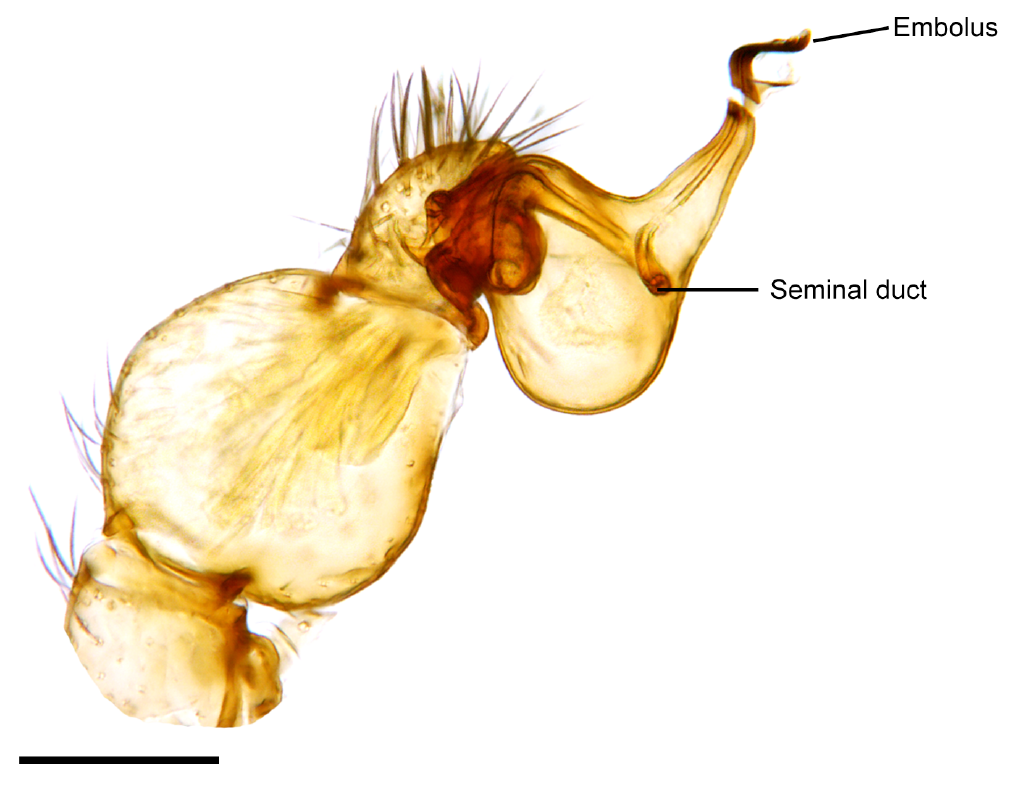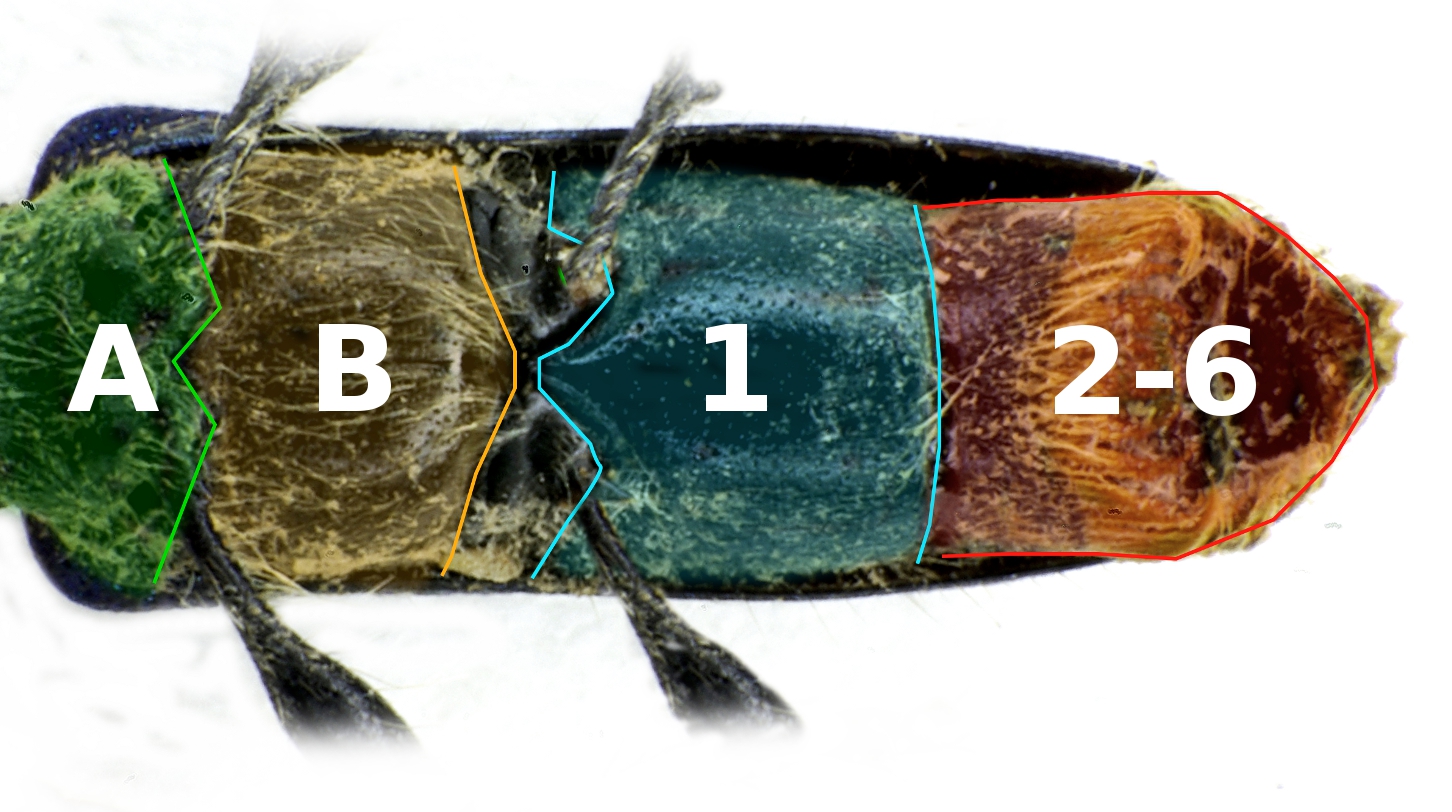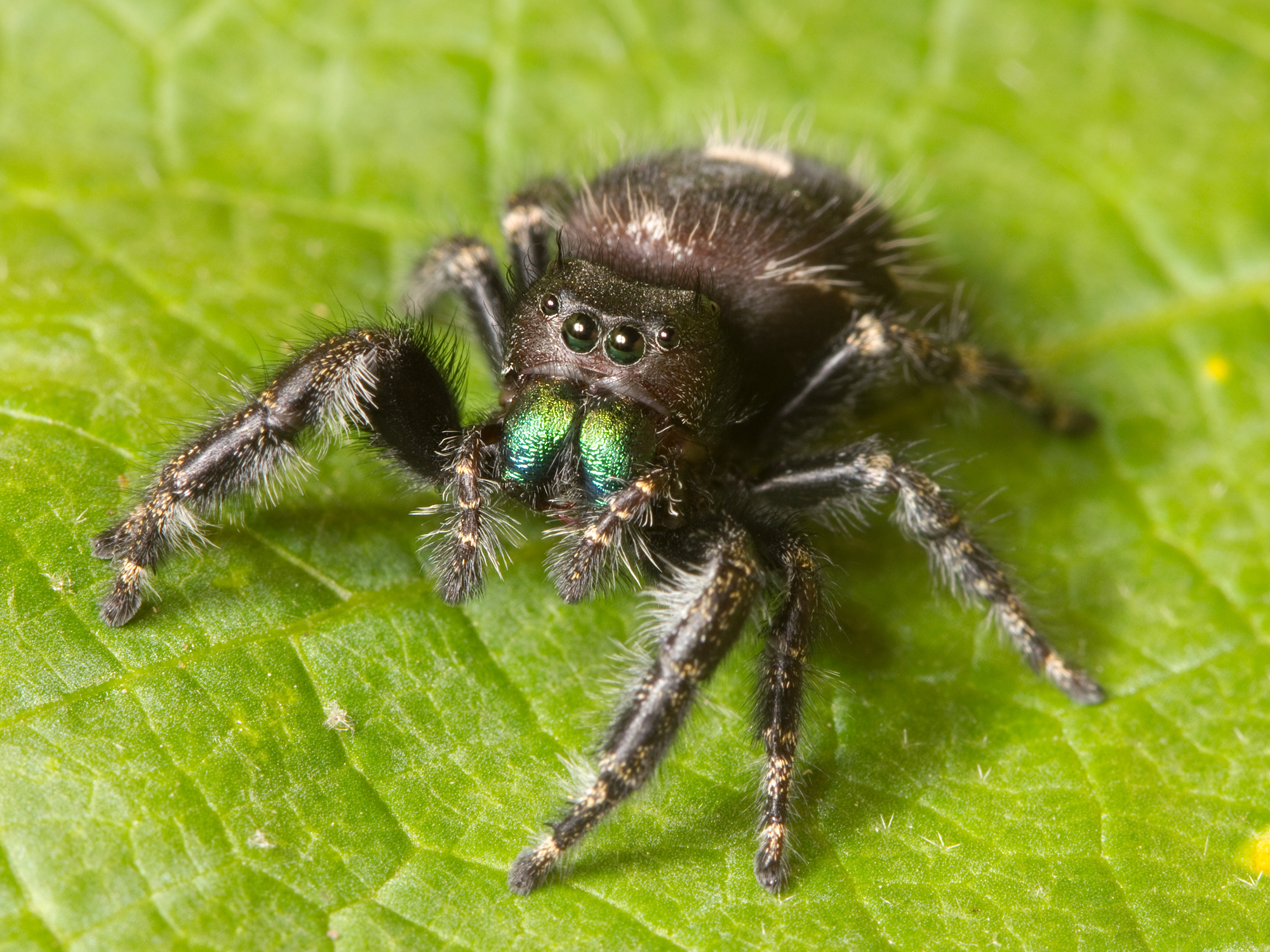|
Mexcala Macilenta
''Mexcala macilenta'' is a species of jumping spider in the genus ''Mexcala'' that lives in Ethiopia and Tanzania. The spider was first defined in 2000 by Wanda Wesołowska and Anthony Russell-Smith. It mimics ants and ant-like wasps, living alongside and preying upon them. The spider is medium-sized to large, with a brown carapace between long and a rusty-brown or greyish-russet abdomen between long. The female is larger than the male. Both male and females have long thin brown legs and a distinctive pattern of a large triangular black marking in the middle of the abdomen. The male copulatory organs have a thin tibial apophysis and lack the triangular lobe on the palpal bulb that other species in the genus possess. Taxonomy ''Mexcala macilenta'' is a jumping spider that was first described by Wanda Wesołowska and Anthony Russell-Smith in 2000. They allocated the species to the genus ''Mexcala'', first raised by George and Elizabeth Peckham in 1902. The genus was a ... [...More Info...] [...Related Items...] OR: [Wikipedia] [Google] [Baidu] |
Mexcala
''Mexcala'' is a genus of jumping spiders that was first described by George and Elizabeth Peckham in 1902. The name is probably derived from the Nahuatl ''mezcal''. Species it contains twenty-one species, found only in Africa, Yemen, and Iran: *'' Mexcala agilis'' Lawrence, 1928 – Congo, Kenya, Malawi, Tanzania, Namibia *'' Mexcala angolensis'' Wesolowska, 2009 – Angola *'' Mexcala caerulea'' (Simon, 1901) – West Africa *'' Mexcala elegans'' Peckham & Peckham, 1903 – Ivory Coast, Malawi, Namibia, Botswana, Zimbabwe, South Africa *'' Mexcala farsensis'' Logunov, 2001 – Iran *'' Mexcala fizi'' Wesolowska, 2009 – Congo, Tanzania *'' Mexcala formosa'' Wesolowska & Tomasiewicz, 2008 – Ethiopia *'' Mexcala kabondo'' Wesolowska, 2009 – Congo, Malawi, Tanzania *'' Mexcala macilenta'' Wesolowska & Russell-Smith, 2000 – Ethiopia, Tanzania *'' Mexcala meridiana'' Wesolowska, 2009 – South Africa *'' Mexcala monstrata'' Wesolowska & van Harten, 1994 – Egypt, Yemen *'' M ... [...More Info...] [...Related Items...] OR: [Wikipedia] [Google] [Baidu] |
Chrysillini
Chrysillini is a tribe of jumping spider in the family Salticidae. In Maddison's 2015 revision of the family, the subfamily Heliophaninae was reclassified as a junior synonym of Chrysillini. Genera * '' Afraflacilla'' * '' Augustaea'' * '' Chrysilla'' * '' Cosmophasis'' * '' Echinussa'' * '' Epocilla'' * ''Festucula'' * ''Hakka'' * ''Helicius'' * '' Heliophanillus'' * ''Heliophanus'' * '' Helvetia'' * '' Icius'' * '' Kupiuka'' * ''Marchena'' * '' Matagaia'' * ''Menemerus'' * ''Mexcala'' * ''Natta'' * '' Ogdenia'' * '' Orsima'' * '' Paraheliophanus'' * '' Phintella'' * '' Plesiopiuka'' * '' Siler'' * '' Tasa'' * '' Theriella'' * ''Wesolowskana'' * ''Yepoella ''Yepoella'' is a monotypic taxon, monotypic genus of Argentinian Salticidae, jumping spiders containing the single species, ''Yepoella crassistyli''. It was first described by María Elena Galiano in 1970, and is found in Argentina. A second spec ...'' References Salticidae Spider tribes ... [...More Info...] [...Related Items...] OR: [Wikipedia] [Google] [Baidu] |
Pedipalp
Pedipalps (commonly shortened to palps or palpi) are the second pair of appendages of chelicerates – a group of arthropods including spiders, scorpions, horseshoe crabs, and sea spiders. The pedipalps are lateral to the chelicerae ("jaws") and anterior to the first pair of walking legs. Overview Pedipalps are composed of six segments or articles: the coxa, the trochanter, the femur, the short patella, the tibia, and the tarsus. In spiders, the coxae frequently have extensions called maxillae or gnathobases, which function as mouth parts with or without some contribution from the coxae of the anterior legs. The limbs themselves may be simple tactile organs outwardly resembling the legs, as in spiders, or chelate weapons ( pincers) of great size, as in scorpions. The pedipalps of Solifugae are covered in setae, but have not been studied in detail. Comparative studies of pedipalpal morphology may suggest that leg-like pedipalps are primitive in arachnids. At present, t ... [...More Info...] [...Related Items...] OR: [Wikipedia] [Google] [Baidu] |
Spinneret
A spinneret is a silk-spinning organ of a spider or the larva of an insect. Some adult insects also have spinnerets, such as those borne on the forelegs of Embioptera. Spinnerets are usually on the underside of a spider's opisthosoma, and are typically segmented. While most spiders have six spinnerets, some have two, four, or eight. They can move both independently and in concert. Most spinnerets are not simple structures with a single orifice producing a single thread, but complex structures of many microscopic spigots, each producing one filament. This produces the necessary orientation of the protein molecules, without which the silk would be weak and useless. Spigots can be singular or found in groups, which also permits spiders to combine multiple filaments in different ways to produce many kinds of silk for various purposes. Spinneret morphology can help arachnologists identify the taxon of a specimen and the specific morphology of a spigot can determine its use as well ... [...More Info...] [...Related Items...] OR: [Wikipedia] [Google] [Baidu] |
Sternum (arthropod Anatomy)
The sternum (pl. "sterna") is the ventral portion of a segment of an arthropod thorax or abdomen. In insects, the sterna are usually single, large sclerites, and external. However, they can sometimes be divided in two or more, in which case the subunits are called sternites, and may also be modified on the terminal abdominal segments so as to form part of the functional genitalia, in which case they are frequently reduced in size and development, and may become internalized and/or membranous. For a detailed explanation of the terminology, see Kinorhynchs have tergal and sternal plates too, though seemingly not homologous with those of arthropods.Sørensen, M. V. et al. Phylogeny of Kinorhyncha based on morphology and two molecular loci. PLoS One 10, 1–33 (2015). Ventrites are externally visible sternites. Usually the first sternite is covered up, so that vertrite numbers do not correspond to sternid numbers. The term is also used in other arthropod groups such as crustacea ... [...More Info...] [...Related Items...] OR: [Wikipedia] [Google] [Baidu] |
Labium (arthropod Mouthpart)
The mouthparts of arthropods have evolved into a number of forms, each adapted to a different style or mode of feeding. Most mouthparts represent modified, paired appendages, which in ancestral forms would have appeared more like legs than mouthparts. In general, arthropods have mouthparts for cutting, chewing, piercing, sucking, shredding, siphoning, and filtering. This article outlines the basic elements of four arthropod groups: insects, myriapods, crustaceans and chelicerates. Insects are used as the model, with the novel mouthparts of the other groups introduced in turn. Insects are not, however, the ancestral form of the other arthropods discussed here. Insects Insect mouthparts exhibit a range of forms. The earliest insects had chewing mouthparts. Specialisation includes mouthparts modified for siphoning, piercing, sucking and sponging. These modifications have evolved a number of times. For example, mosquitoes (which are flies) and aphids (which are bugs) both ... [...More Info...] [...Related Items...] OR: [Wikipedia] [Google] [Baidu] |
Chelicerae
The chelicerae () are the mouthparts of the subphylum Chelicerata, an arthropod group that includes arachnids, horseshoe crabs, and sea spiders. Commonly referred to as " jaws", chelicerae may be shaped as either articulated fangs, or similarly to pincers. Some chelicerae, such as those found on nearly all spiders, are hollow and contain (or are connected to) venom glands, and are used to inject venom into prey or a perceived threat. In '' Pisaurina mira'', also known as the nursery web spider, the chelicerae are utilized to snatch the prey once it becomes within reach, facilitating the "sit-and-wait ambush predator" behavior. Both pseudoscorpions and harvestmen have structures on their chelicerae that are used for grooming (papillae in pseudoscorpions, cheliceral teeth in Opiliones). Types Chelicerae can be divided into three kinds: jackknife chelicerae, scissor chelicerae, and 3-segmented chelate chelicerae. Jackknife chelicerae The jackknife chelicera is subchelate ... [...More Info...] [...Related Items...] OR: [Wikipedia] [Google] [Baidu] |
Spider Vision
The eyes of spiders vary significantly in their structure, arrangement, and function. They usually have eight, each being a simple eye with a single lens (optics), lens rather than multiple units as in the compound eyes of insects. The specific arrangement and structure of the eyes is one of the features used in the identification and classification of different species, genera, and families. Most Haplogynae, haplogynes have six eyes, although some have eight (Plectreuridae), four (e.g., ''Tetrablemma'') or even two (most Caponiidae). In some cave species, there are no eyes at all (e.g. Stalita taenaria). Sometimes one pair of eyes is better developed than the rest. Several families of hunting spiders, such as jumping spiders and wolf spiders, have fair to excellent vision. The main pair of eyes in jumping spiders even sees in colour. Structure and anatomy Spiders' eyes are Simple eye in invertebrates, simple eyes, or ''ocelli'' (singular ''ocellus''), meaning their eyes have a si ... [...More Info...] [...Related Items...] OR: [Wikipedia] [Google] [Baidu] |
Latin
Latin (, or , ) is a classical language belonging to the Italic branch of the Indo-European languages. Latin was originally a dialect spoken in the lower Tiber area (then known as Latium) around present-day Rome, but through the power of the Roman Republic it became the dominant language in the Italian region and subsequently throughout the Roman Empire. Even after the fall of Western Rome, Latin remained the common language of international communication, science, scholarship and academia in Europe until well into the 18th century, when other regional vernaculars (including its own descendants, the Romance languages) supplanted it in common academic and political usage, and it eventually became a dead language in the modern linguistic definition. Latin is a highly inflected language, with three distinct genders (masculine, feminine, and neuter), six or seven noun cases (nominative, accusative, genitive, dative, ablative, and vocative), five declensions, four ... [...More Info...] [...Related Items...] OR: [Wikipedia] [Google] [Baidu] |
Heliophanus
''Heliophanus'' is a genus of the spider family Salticidae (jumping spiders). Most of the almost 170 described species occur in Africa, with many others found in the Palearctic region from Europe to Japan. Species , the World Spider Catalog accepted the following species: * '' Heliophanus abditus'' Wesołowska, 1986 – Syria * '' Heliophanus aberdarensis'' Wesołowska, 1986 – Kenya * '' Heliophanus activus'' ( Blackwall, 1877) – Seychelles * '' Heliophanus acutissimus'' Wesołowska, 1986 – Algeria * '' Heliophanus aeneus'' ( Hahn, 1832) – Palearctic * '' Heliophanus aethiopicus'' Wesołowska, 2003 – Ethiopia * '' Heliophanus africanus'' Wesołowska, 1986 – South Africa * '' Heliophanus agricola'' Wesołowska, 1986 – Algeria, Spain * '' Heliophanus agricoloides'' Wunderlich, 1987 – Canary Islands * '' Heliophanus alienus'' Wesołowska, 1986 – Cameroon * '' Heliophanus anymphos'' Wesołowska, 2003 – Kenya * '' Heliophanus apiatus'' Simon, 1868 – Spain ... [...More Info...] [...Related Items...] OR: [Wikipedia] [Google] [Baidu] |
Jerzy Prószyński
Jerzy Prószyński (born 1935 in Warsaw) is a Polish arachnologist specializing in systematics of jumping spiders (family Salticidae). He is a graduate of the University of Warsaw, a long-term employee of the Siedlce University of Natural Sciences and Humanities and the Institute of Zoology of the Polish Academy of Sciences in Warsaw. Biography In 1957 he completed his biological studies at the University of Warsaw. During his studies he was employed at the Institute of Zoology of the Polish Academy of Sciences in Warsaw, where he conducted research on spiders in the Kampinos Forest. Between 1963 and 1967 he lectured on zoology at the University of Ghana. In 1966 he obtained his Ph.D. at the Adam Mickiewicz University in Poznań. A year later he was given the opportunity to pursue a postdoctoral fellowship at Harvard University, but he was refused a passport. In 1972 he was employed at the Higher School of Education in Siedlce (later the Siedlce University of Natural Scie ... [...More Info...] [...Related Items...] OR: [Wikipedia] [Google] [Baidu] |
Salticoida
Salticoida is an unranked clade of the jumping spider family Salticidae. It is the larger and more widespread of the two subdivisions of the "typical" jumping spiders (subfamily Salticinae), occurring effectively world-wide. Its sister clade is Amycoida, which is also very diverse ecologically but has a mostly South American distribution. Systematics and evolution Salticoida includes the bulk of extant jumping spider diversity, with over 400 genera organized phylogenetically into 18 tribes according to Wayne Maddison's 2015 proposal. The age and origin of the Salticoida are not well determined. Certainly, by the late Paleogene the major lineages were recognizably distinct as indicated by the fossil evidence and molecular phylogeny. Thus, the salticoids presumably originated during or around the PETM or a bit earlier, but no corresponding fossils have been found yet. Their sister lineage, the Amycoida, probably originated by dispersal across the ocean to South America, which ... [...More Info...] [...Related Items...] OR: [Wikipedia] [Google] [Baidu] |






